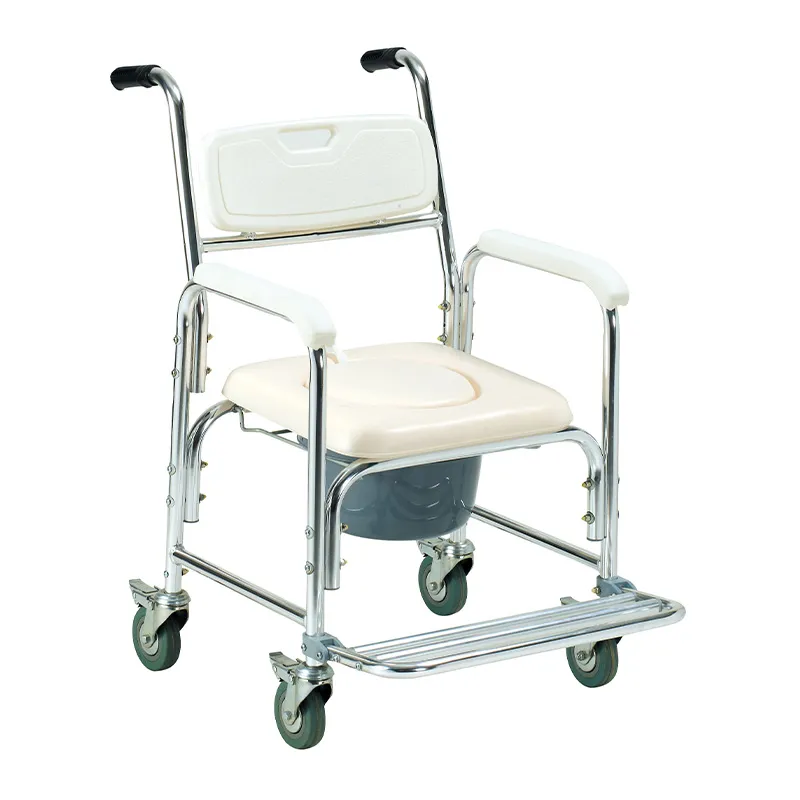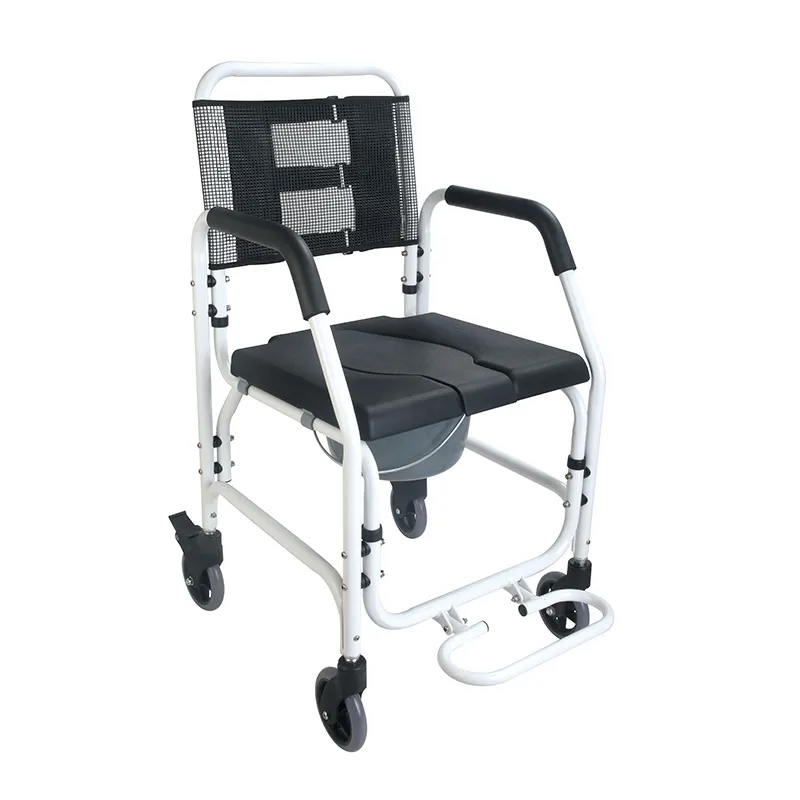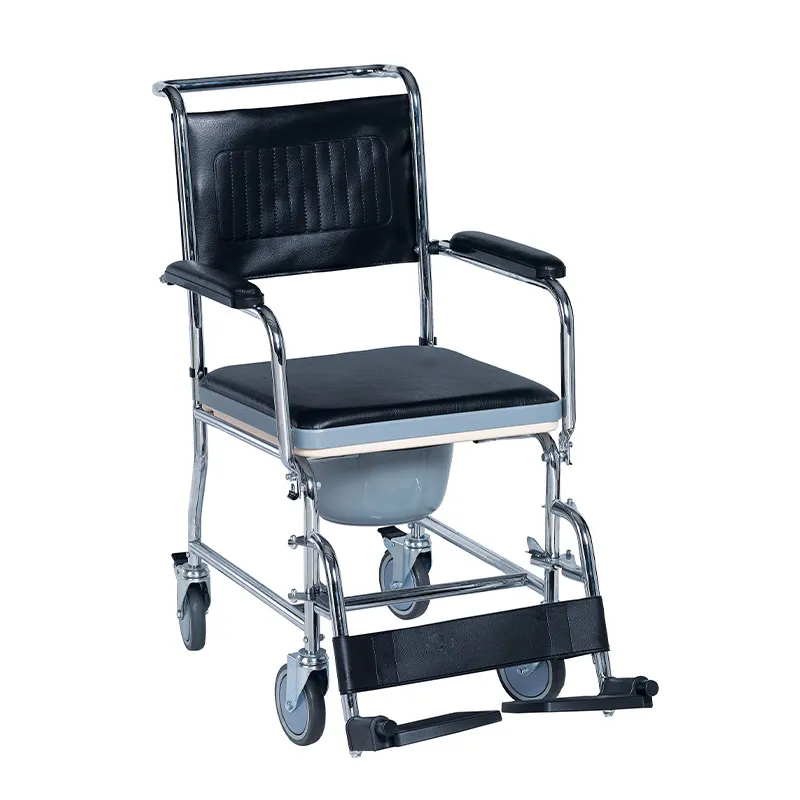
Is the toilet wheelchair suitable for different types of disabilities?
2024-10-08 15:30
The toilet wheelchair is an auxiliary device that combines the functions of a wheelchair and a commode chair. It is designed to provide more convenience for people with disabilities with limited mobility. However, is the toilet wheelchair suitable for different types of disabilities?
This article will deeply analyze the functional characteristics of the potty wheelchair, explore its applicability in various disability situations, and help readers understand the practical utility of this device.

What is the role of the toilet wheelchair?
The toilet wheelchair is a multifunctional device that integrates the mobility function of a traditional wheelchair and the toilet function of a commode chair. Its design usually includes several key features: mobility function, commode chair function, safety and comfort.
1. Mobility function: The potty wheelchair is equipped with wheels, and the user can move it by pushing it or being pushed by others, similar to an ordinary wheelchair.
2. Commode chair function: There is a commode under the wheelchair seat, and the user can defecate without leaving the wheelchair. The commode can be easily removed and cleaned.
3. Safety and comfort: Many toilet wheelchairs are equipped with armrests, footrests and backrests to improve the user's comfort and safety.
What types of disabilities are potty wheelchairs suitable for?
The versatile design of the toilet commode wheelchair makes it applicable in many disability situations. However, different types of disabilities have different specific needs for wheelchairs, so the applicability of commode wheelchairs also varies.
The disabilities that commode wheelchairs are suitable for are:
1. Spinal cord injury,
2. Multiple sclerosis,
3. Parkinson's disease,
4. Osteoarthritis and fractures,
5. Alzheimer's disease and other geriatric diseases.
Spinal cord injury:
Spinal cord injury (SCI) patients suffer from lower limb paralysis or severe motor function limitation due to partial or complete damage to the spinal cord. For such patients, the mobility and toileting functions of toilet commode wheelchairs are very important.
● Advantages: Commode wheelchairs allow patients to move and toilet independently or with minimal assistance, reducing the need for frequent transfers and reducing the risk of secondary injuries.
● Limitations: Depending on the severity of spinal cord injury, some patients may need specially designed wheelchairs with higher support and comfort, which standard commode wheelchairs may not fully meet.
Multiple Sclerosis:
People with Multiple Sclerosis (MS) often face muscle weakness, coordination problems, and balance issues. As the disease progresses, mobility and toileting become increasingly difficult.
● Advantages: Commode wheelchairs offer a convenient solution for people with MS, especially when the disease is more severe, without the need for frequent transfers from wheelchair to commode chair.
● Limitations: Some people with MS may need special wheelchair accessories, such as additional support and stabilization devices, to ensure safety and comfort.
Parkinson's Disease:
People with Parkinson's Disease often face problems such as slow movement, muscle stiffness, and postural instability. Commode wheelchairs can provide greater independence and convenience for these patients.
● Advantages: Commode wheelchairs reduce the number of movements and transfers required when using the toilet, reducing the risk of falls and injuries.
● Limitations: Due to the muscle stiffness and slow movement of people with Parkinson's Disease, some standard toilet commode wheelchairs may need to be adjusted to ensure that they can be used safely and effectively.

Osteoarthritis and fractures:
Osteoarthritis and fracture patients often face joint pain, limited mobility, and difficulty in rehabilitation. Commode wheelchairs can provide important assistance to these patients.
● Advantages: Commode wheelchairs can reduce the pain and inconvenience of patients in the process of toileting, especially in the recovery period of fractures, avoiding frequent transfers and movements.
● Limitations: For some patients with severe fractures, special support and more comfortable wheelchairs may be required instead of standard toilet commode wheelchairs.
Alzheimer's and other geriatric diseases:
Alzheimer's and other geriatric diseases patients often face problems of memory loss, slow movement, and difficulty in toileting. Commode wheelchairs can help elderly patients maintain a certain degree of independence.
● Advantages: Commode wheelchairs can reduce the confusion and inconvenience of elderly patients in the process of toileting, especially for patients with memory loss, reducing the need for frequent transfers.
● Limitations: Because elderly patients may need more care and support, some elderly patients may need to be equipped with more assistive devices and caregivers to help.

What are the advantages and disadvantages of commode wheelchairs?
Advantages of toilet wheelchairs:
1. Versatility
2. Strong independence
3. High safety
● Versatility: toilet wheelchairs integrate mobility and toileting functions, reducing the need for frequent transfers and improving ease of use.
● Strong independence: Provides patients with a certain degree of independence, enabling them to use the toilet with minimal help, enhancing self-esteem and confidence.
● High safety: Reduces the risk of falls and injuries during toileting, especially for patients with limited mobility and prone to falls.
Disadvantages of toilet wheelchairs:
1. Poor comfort and support
2. High customization requirements
3. Poor portability
● Poor comfort and support: Standard potty wheelchairs may not meet the comfort and support needs of all patients, especially for patients with severe disabilities or special needs.
● High customization requirements: Some patients may need a specially made toilet wheelchair to meet their specific physical conditions and disability types, which increases the complexity and cost of the equipment.
● Poor portability: The potty wheelchair is relatively heavy and bulky, and may not be suitable for all environments and usage scenarios, especially in small spaces or when frequent movement is required.
In summary, the toilet wheelchair, as a multifunctional assistive device, is suitable for a variety of disability types, including spinal cord injury, multiple sclerosis, Parkinson's disease, osteoarthritis, and Alzheimer's disease. Its multifunctional design provides great convenience and independence for patients, reduces the need for frequent transfers, and improves safety.








